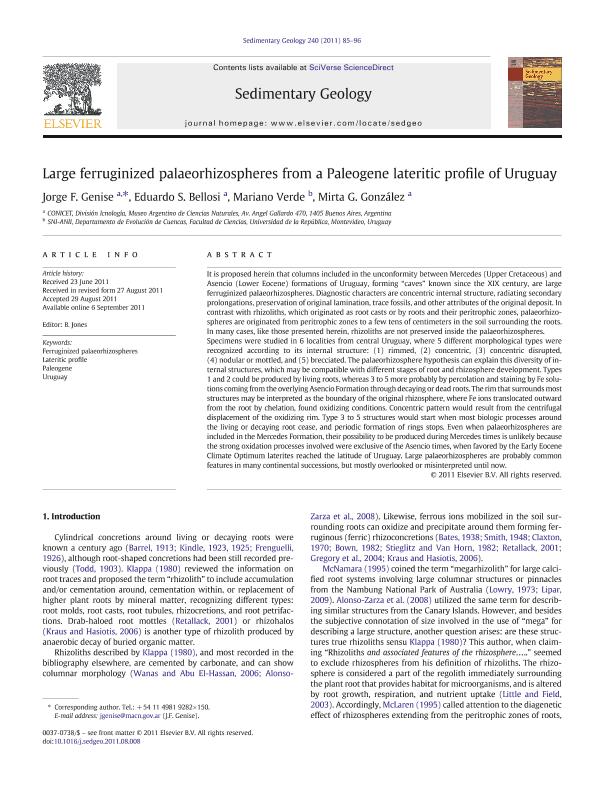Artículo
Large ferruginized palaeorhizospheres from a Paleogene lateritic profile of Uruguay
Fecha de publicación:
10/2011
Editorial:
Elsevier Science
Revista:
Sedimentary Geology
ISSN:
0037-0738
Idioma:
Inglés
Tipo de recurso:
Artículo publicado
Clasificación temática:
Resumen
It is proposed herein that columns included in the unconformity between Mercedes (Upper Cretaceous) and Asencio (Lower Eocene) formations of Uruguay, forming "caves" known since the XIX century, are large ferruginized palaeorhizospheres. Diagnostic characters are concentric internal structure, radiating secondary prolongations, preservation of original lamination, trace fossils, and other attributes of the original deposit. In contrast with rhizoliths, which originated as root casts or by roots and their peritrophic zones, palaeorhizospheres are originated from peritrophic zones to a few tens of centimeters in the soil surrounding the roots. In many cases, like those presented herein, rhizoliths are not preserved inside the palaeorhizospheres.Specimens were studied in 6 localities from central Uruguay, where 5 different morphological types were recognized according to its internal structure: (1) rimmed, (2) concentric, (3) concentric disrupted, (4) nodular or mottled, and (5) brecciated. The palaeorhizosphere hypothesis can explain this diversity of internal structures, which may be compatible with different stages of root and rhizosphere development. Types 1 and 2 could be produced by living roots, whereas 3 to 5 more probably by percolation and staining by Fe solutions coming from the overlying Asencio Formation through decaying or dead roots. The rim that surrounds most structures may be interpreted as the boundary of the original rhizosphere, where Fe ions translocated outward from the root by chelation, found oxidizing conditions. Concentric pattern would result from the centrifugal displacement of the oxidizing rim. Type 3 to 5 structures would start when most biologic processes around the living or decaying root cease, and periodic formation of rings stops. Even when palaeorhizospheres are included in the Mercedes Formation, their possibility to be produced during Mercedes times is unlikely because the strong oxidation processes involved were exclusive of the Asencio times, when favored by the Early Eocene Climate Optimum laterites reached the latitude of Uruguay. Large palaeorhizospheres are probably common features in many continental successions, but mostly overlooked or misinterpreted until now.
Palabras clave:
Ferruginized Palaeorhizospheres
,
Lateritic Profile
,
Paleogene
,
Uruguay
Archivos asociados
Licencia
Identificadores
Colecciones
Articulos(MACNBR)
Articulos de MUSEO ARG.DE CS.NAT "BERNARDINO RIVADAVIA"
Articulos de MUSEO ARG.DE CS.NAT "BERNARDINO RIVADAVIA"
Citación
Genise, Jorge Fernando; Bellosi, Eduardo Sergio; Verde, Mariano; Gonzalez, Mirta Gladys; Large ferruginized palaeorhizospheres from a Paleogene lateritic profile of Uruguay; Elsevier Science; Sedimentary Geology; 240; 3-4; 10-2011; 85-96
Compartir
Altmétricas




